
|
|

|
Hokusai - Ehon Sumida Gawa - Print 3-1

|
|

|
This is the first of two places in the three Ehon Sumida Gawa picture books where Hokusai interrupts his otherwise continuous presentation of views of both banks of the Sumida river.
This print is a great example of a pictorial “pars pro toto”: a large temple complex is hinted at by just showing a very small part of it. The temple complex is called Kinryūzan Sensōji temple (金龍山浅草寺), dedicated to Kannon, and located in the district of Asakusa (浅草, which means “shallow grass”). It is interesting to note that Asakusa (the district, originally the village) and Sensō (the temple) are both written with the same kanji (浅草), the kun reading (based on the native Japanese pronunciation) of these two kanji being Asakusa while their on reading (based on the original Chinese pronunciation) is Sensō.
The temple is very old, much older than the city of Edo. It was built after two fishermen had found a statue of bodhisattva Kannon in 628, as related in the story in prints 2-11 and 2-12. The statue was enshrined in a temple named Asakusa Kannon temple. When moving to Edo in the late 1500s the first shōgun Tokugawa Ieyasu made Asakusa Kannon temple the official family temple of the Tokugawa family. He then also renamed the temple to Sensōji, the on reading of the kanji for Asakusa.
A first impression of the Sensōji temple complex can be obtained from a detail of this Edo map of 1858 (click to enlarge):
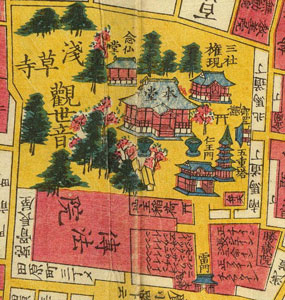
|
Schematic view of Kinryūzan Sensōji temple from an Edo map of 1858 |
The buildings displayed in this map are - among others: the Kaminarimon gate (雷門, which translates into the “Thunder gate”), the Niōmon gate (仁王門, which translates into the “Deva King’s gate”), the Hondō (本道, which translates into the temple’s “Main building”), and the Gojūnotō pagoda (五重の塔, which translates into the “Five-storied pagoda”). The Kaminarimon and Niōmon gates and the Hondō are famous for their huge lanterns. The 275 meter stretch between the Thunder gate and the Deva King’s gate - now as then - houses a long row of souvenir and toy shops known as the Nakamisedōri (仲見世通り, which translates into “shopping street in the precincts of a temple”).
Around 1820 Totoya Hokkei designed this print containing a wonderful aerial view of Sensōji temple and the northern part of the Sumida river with Mount Tsukuba in the far distance (click to enlarge):
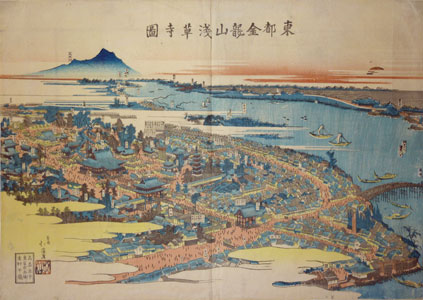
|
Kinryūzan Sensōji temple in the East Capital designed by Totoya Hokkei (ca. 1820-23) |
This print covers all the areas displayed in Hokusai’s third Ehon Sumida Gawa book, and some areas of his second book as well.
In the foreground in the bottom right of this print we see Komagatadō hall, as also displayed in Hokusai’s prints 2-11 and 2-12. A bit further upstream is Ōkawa bridge and the bridge visible even further upstream on the east bank is Makura bridge, see prints 2-13 and 2-14. Right across the river from Makura bridge you can clearly discern Matsuchiyama hill rising up in Hokkei’s print on the west bank between two patches of fog; this hill is also the subject of Hokusai’s prints 3-4 and 3-5. Next Imado bridge is visible just behind Matsuchiyama hill in Hokkei’s print. The plovers on the surface of Sumida river seen on the right of Matsuchiyama hill and Imado bridge in Hokkei’s print are also displayed in Hokusai’s prints 3-8 and 3-9.
The two smoke columns rising just a bit further up on the westbank of the river in Hokkei’s print are from the kilns of Imado village where roof tiles are being made, as also depicted in Hokusai’s prints 3-6 and 3-7. To the left of these smoke columns part of the Nihon embankment leading up to the Yoshiwara pleasure quarters is visible. Further upstream we see Hashiba and the Hashiba ferry crossing the river, and even further upstream is the torii gate of Inari Miyōjin shrine in Massaki shown in Hokusai’s prints 3-10 and 3-11.
Last but not least - and even though there are some obvious registration problems in this print - the bottom left half of Hokkei’s print provides an absolutely grand aerial view of the Sensōji temple complex and its large crowds of visitors, including the Nakamise row of shops in between the Kaminarimon and Niōmon gates. Moving up north and away from the city, the contrast between the densely populated west bank of the Sumida river and the farmlands on the east bank is also quite noticeable in this print.
There are many other Japanese woodblock prints depicting the Sensōji temple complex and its gates and buildings. Hiroshige, for example, designed the following two prints, one showing the Kaminarimon gate with its big lantern and part of the Nakamisedōri, and the other providing a view of the temple complex from across the river (click to enlarge):
The kanji for “Kameya” in the title of the print on the left are 亀屋. The two kanji are also clearly visible on the dark blue noren of the teahouse in the foreground on the right of this print. They translate into “Turtle teahouse” which is confirmed by the detailed drawing of a turtle on the same noren, as well as by the stylized drawings of turtles at the bottom of the railing of the balcony on the second floor of the teahouse. Hidden behind the metal wire mesh on the left of the Kaminarimon gate in this print is an image of the thunder god after whom the gate is named, paired on the right with a wind god.
These are two 20th century prints of the Main building of Sensōji temple designed by Kawase Hasui and Tsuchiya Koitsu:
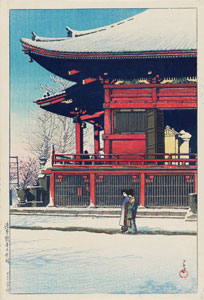
|
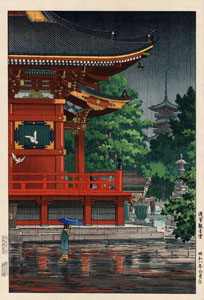
|
| Clearing Sky after Snow, Kannon Temple, Asakusa, from the series “Twenty Views of Tokyo” by Kawase Hasui (1926) |
Asakusa Kannon Temple by Tsuchiya Koitsu (1933) |
For even more Japanese woodblock prints dedicated to Asakusa Kannon temple, please have a look at Serge Astières’s Shin-Hanga website here.
In 1945 the Sensōji temple complex was bombed by the allied forces and completely destroyed. After World War II the whole originally wooden complex was rebuilt in ferroconcrete: the Main building in 1958, the Thunder gate in 1960, the Deva King’s gate in 1964, and the Five-storied pagoda (now to the left of the Deva King’s gate) in 1973. The end result can be seen in this overview:
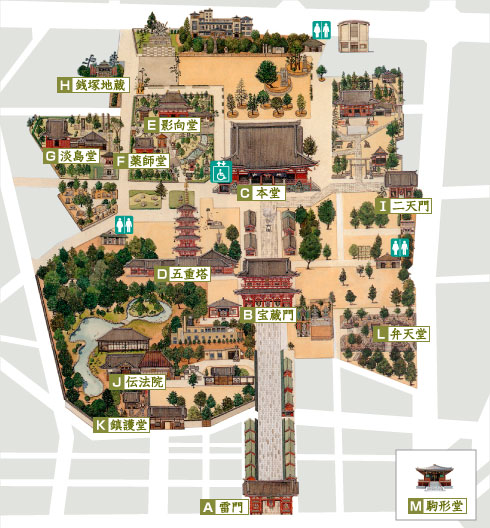
|
Overview of Kinryūzan Sensōji temple as it looks today |
The Deva King’s gate is now called the Hōzōmon gate (宝蔵門, which translates into the “Treasure room gate”). These are some pictures I took in 2017 at the temple complex as well as the stamps and calligraphy I obtained from a priest at the Sensōji temple in my goshuinchō temple stamp book (click to enlarge):
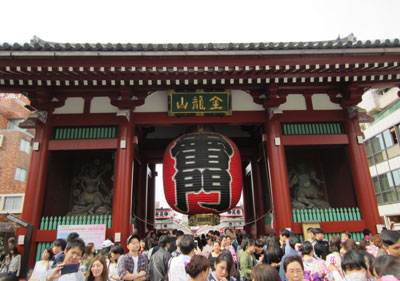
|
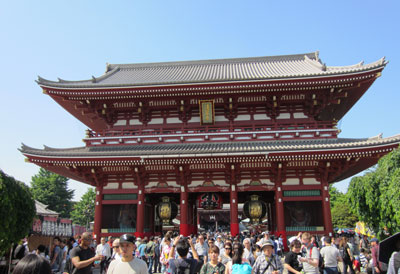
|
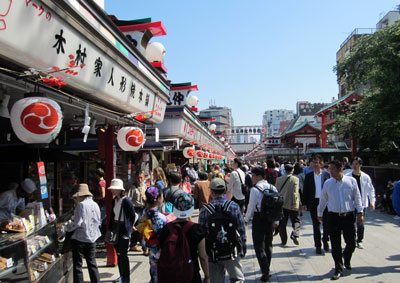
|
| The Kaminarimon gate | The Niōmon gate, now called the Hōzōmon gate | The Nakamisedōri street |
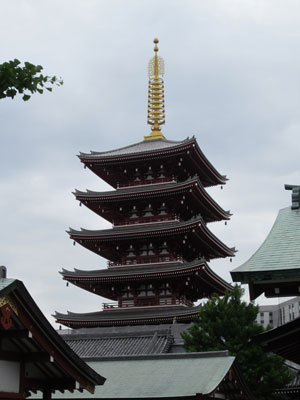
|
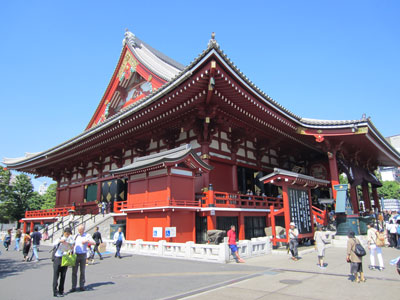
|
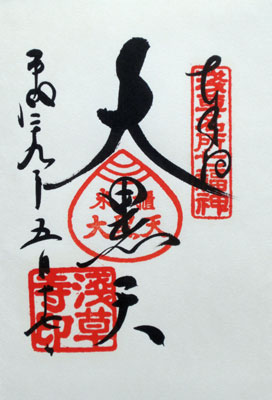
|
| The Gojūnotō pagoda | The Hondō | Stamps and calligraphy in my goshuinchō temple stamp book |
The kanji in the calligraphy in the left column of the page in my goshuinchō are 平成二十九年五月十九日. This translates into Heisei 29, the 5th month, the 19th day, and thus in 2017, May 19: the date of my visit to the temple.
Should you happen to be in Tokyo and interested in Japanese woodblock printmaking: make sure to visit a Mokuhankan Print Party in Asakusa!